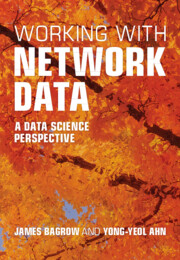Book contents
- Frontmatter
- Contents
- Preface
- Part I Background
- Part II Applications, tools, and tasks
- Chapter 5 The life cycle of a network study
- Chapter 6 Gathering data
- Chapter 7 Extracting networks from data — the “upstream task”
- Chapter 8 Implementation: storing and manipulating network data
- Chapter 9 Incorporating node and edge attributes
- Chapter 10 Awful errors and how to amend them
- Chapter 11 Explore and explain: statistics for network data
- Chapter 12 Understanding network structure and organization
- Chapter 13 Visualizing networks
- Chapter 14 Summarizing and comparing networks
- Chapter 15 Dynamics and dynamic networks
- Chapter 16 Machine learning
- Interlude — Good practices for scientific computing
- Part III Fundamentals
- Conclusion
- Bibliography
- Index
Chapter 12 - Understanding network structure and organization
from Part II - Applications, tools, and tasks
Published online by Cambridge University Press: 06 June 2024
- Frontmatter
- Contents
- Preface
- Part I Background
- Part II Applications, tools, and tasks
- Chapter 5 The life cycle of a network study
- Chapter 6 Gathering data
- Chapter 7 Extracting networks from data — the “upstream task”
- Chapter 8 Implementation: storing and manipulating network data
- Chapter 9 Incorporating node and edge attributes
- Chapter 10 Awful errors and how to amend them
- Chapter 11 Explore and explain: statistics for network data
- Chapter 12 Understanding network structure and organization
- Chapter 13 Visualizing networks
- Chapter 14 Summarizing and comparing networks
- Chapter 15 Dynamics and dynamic networks
- Chapter 16 Machine learning
- Interlude — Good practices for scientific computing
- Part III Fundamentals
- Conclusion
- Bibliography
- Index
Summary
In this chapter, we focus on statistics and measures that quantify a networks structure and characterize how it is organized. These measures have been central to much of network science, and a vast array of material is available to us, spanning across all scales of the network. The measures we discuss include general-purpose measures and those specialized to particular circumstances, which allow us to better get a handle on the network data. Network science has generated a dizzying array of valuable measures over the years. For example, we can measure local structures, motifs, patterns of correlations within the network, clusters and communities, hierarchy, and more. These measures are used for exploratory and confirmatory analyses, which we discussed in the previous chapter. With the measures of this chapter, we can understand the patterns in our networks, and using statistical models, we can put those patterns on a firm foundation.
Keywords
- Type
- Chapter
- Information
- Working with Network DataA Data Science Perspective, pp. 165 - 202Publisher: Cambridge University PressPrint publication year: 2024

